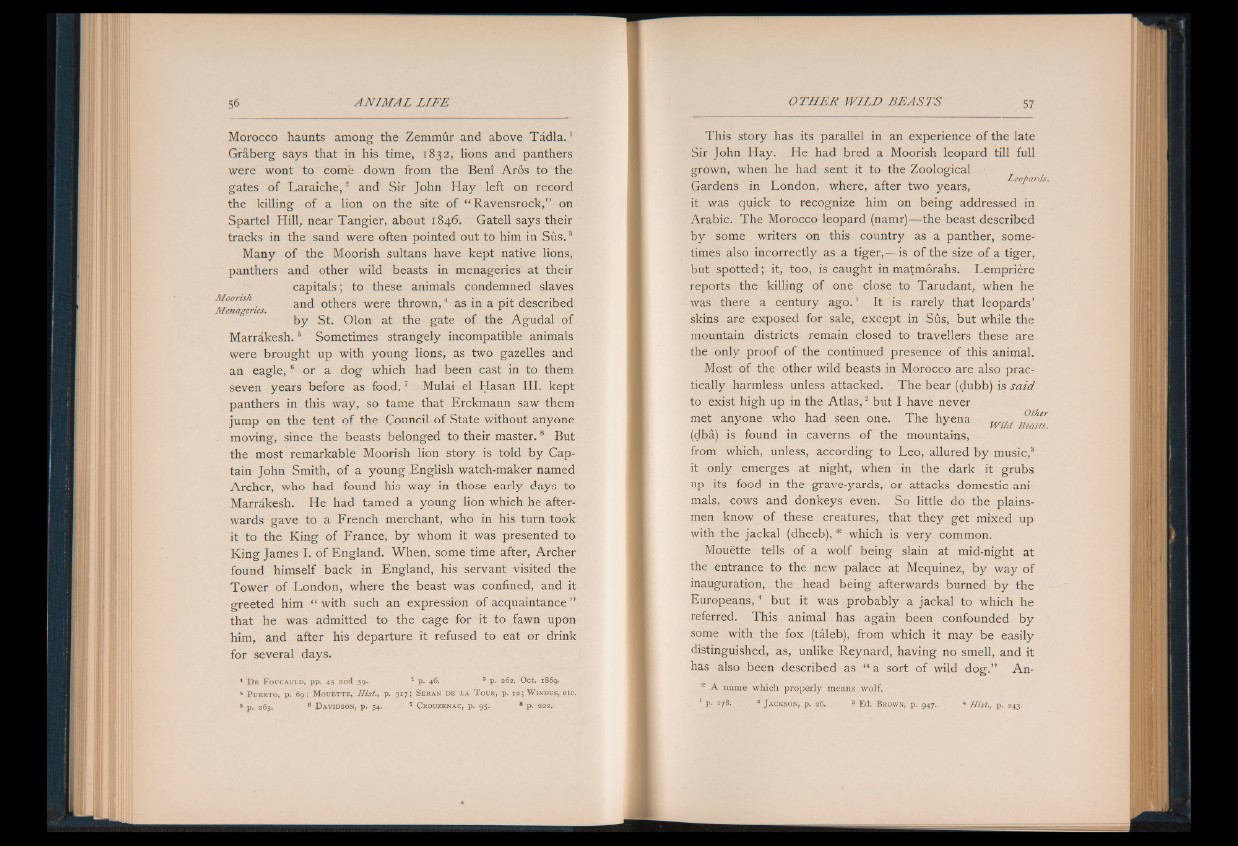
Morocco haunts among the Zemmur and above Tadla .1
Graberg says that in his time, 1832, lions and panthers
were wont to come down from the Beni Aros to the
gates of Laraiche,2 and Sir John Hay left on record
the killing of a lion on the site of “ Ravensrock,” on
Spartel Hill, near Tangier, about 1846. Gatell says their
tracks in the sand were often pointed out to him in Su s.3
Many of the Moorish sultans have kept native lions,
panthers and other wild beasts in menageries at their
capitals; to these animals condemned slaves
Moons and others were thrown,4 as in a pit described Menageries. 1
by St. Olon at the gate of the Agudal of
Marrakesh.5 Sometimes strangely incompatible animals
were brought up with young lions, as two gazelles and
an e a g le ,6 or a dog which had been cast in to them
seven years before as food.7 Mulai el Hasan III. kept
panthers in this way, so tame that Erckmann saw them
jump on the tent of the Council o f State without anyone
moving, since the beasts belonged to their master.8 But
the most remarkable Moorish lion story is told by Captain
John Smith, of a young English watch-maker named
Archer, who had found his way in those early days to
Marrakesh. He had tamed a young lion which he afterwards
gave to a French merchant, who in his turn took
it to the King of France, by whom it was presented to
King James I. of England. When, some time after, Archer
found himself back in England, his servant visited the
Tower of London, where the beast was confined, and it
greeted him “ with such an expression of acquaintance1
that he was admitted to the cage for it to fawn upon
him, and after his departure it refused to eat or drink
for several days.
1 D e F o u c a u l d , p p . 45 an d 59.- 2 p. 46. 3 p . 262, Oct. 1869.
* P u e r t o , p . 6 9 ; M o u e t t e , Hist., p . 3 1 7 ; S e r a n d e l a T o u r , p. 1 2 ; W in d u s , e t c .
6 p . 263. 3 D a v id s o n , p . 54. 7 C r o u z e n a c , p. 95. 8 p. 222,
This story has its parallel in an experience o f the late
Sir John Hay. He had bred a Moorish leopard till full
grown, when he had sent it to the Zoological
Gardens in London, where, after two years,
it was quick to recognize him on being addressed in
Arabic. The Morocco leopard (namr)— the beast described
by some writers on this country as a panther, sometimes
also incorrectly as a tiger,— is of the size o f a tiger,
but spotted; it, too, is caught in matmorahs. Lempriere
reports the killing of one close to Tarudant, when he
was there a century a g o .1 It is rarely that leopards’
skins are exposed for sale, except in Sus, but while the
mountain districts remain closed to travellers these are
the only proof of the continued presence of this animal.
Most of the other wild beasts in Morocco are also practically
harmless unless attacked. The bear (dubb) is said
to exist high up in the A tla s ,2 but I have never
met anyone who had seen one. The hyena |g j|| g |j||i
(dba) is found in caverns of the mountains,
from which, unless, according to Leo, allured by music,3
it only emerges at night, when in the dark it grubs
up its food in the grave-yards, or attacks domestic animals,
cows and donkeys even. So little do the plainsmen
know o f these creatures, that they get mixed up
with the jackal (dheeb), * which is very common.
Mouette tells of a wolf being slain at mid-night at
the entrance to the new palace at Mequinez, by way of
inauguration, the head being afterwards burned by the
Europeans,4 but it was probably a jackal to which he
referred. This animal has again been confounded by
some with the fox (taleb), from which it may be easily
distinguished, as, unlike Reynard, having no smell, and it
has also been described as “ a sort of wild dog.” An-
* A name which properly means wolf.
1 P- l § f | 2 J a c k s o n , p . 26, ? Ed. B r o w n , p . 947. Hist., p . 243.